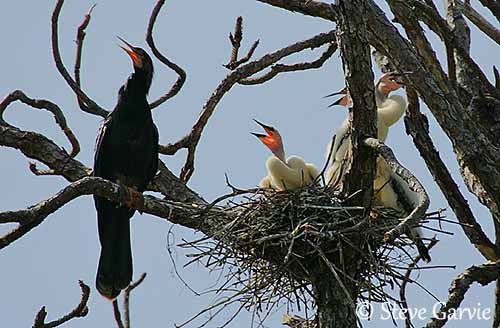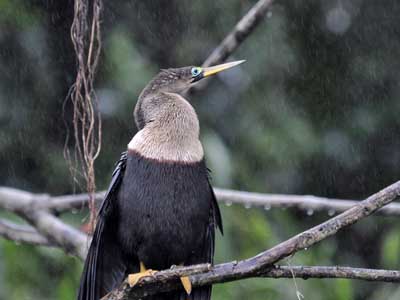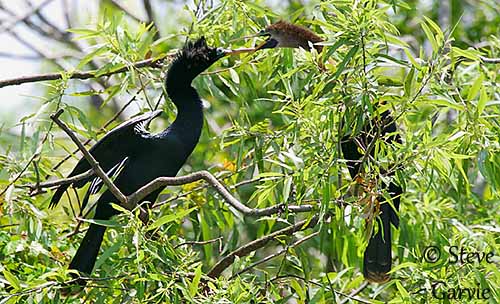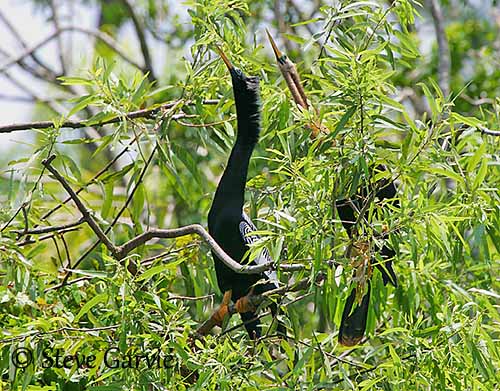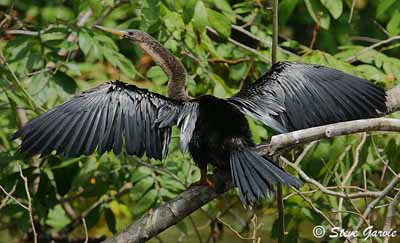
Anhinga
Anhinga anhinga
Suliformes Order - Anhingidae Family
BIOMETRICS:
Length: 75-95 cm; Wingspan: 109 cm; Weight: 1350 g
LONGEVITY: 12 years.
DESCRIPTION:
Anhinga male has dark plumage with green iridescence, with glossy pale grey feathers on upper back and half part of wings. Those are bordered with long white feathers. It has relatively small black head spotted and streaked, as an extension of its very long neck. As other Anhingas, its neck has some vertebrae forming a kind of hinged-mechanism, allowing dashing suddenly its head forwards to jab its prey, with its long sharp bill. It has a small black crest. It has broad wings with white spotting and streaks, long tail often spread in flight, with a white edge on the tip. Legs and webbed feet are pale yellow.
Bill is pale orange yellow, with dark tip and orange base. Lores are greenish blue. Eyes are reddish. Anhingas in breeding plumage have a blue ring around their eyes.

Female is duller than male, with buff brown neck and upper breast, and has not silver patches on wings. In breeding plumage, she has blue lores and eye-ring.
Juvenile has uniform brown plumage.
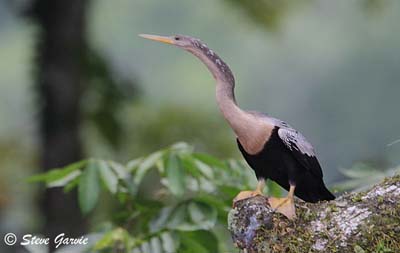
VOICE: SOUNDS BY XENO-CANTO
Anhinga’s call is a raspy croaking. Its calls consist of clicks, croaks and grunts.
It usually calls near or on the nest, or during the flight or while perching. Usually, Anhinga is a quiet bird.
HABITAT:
Anhinga prefers fresh or brackish waters, and we can see it sometimes on coasts. It lives near lakes, marches, mangroves stamps with thick vegetation and tall trees, and in shallow bays and lagoons.
RANGE:
Anhinga occurs all year in coastal areas of southwest of United States, from North Carolina to Texas. But we can find it also in Mexico, Central America, Panama and Cuba. In South America, it is found from Colombia to Ecuador, and from east of Andes to Argentina.
Anhingas occur worldwide in tropical and subtropical regions.
BEHAVIOUR:
Anhinga often swims with only head and neck out from water, giving it the name of “snake-bird”, looking as swimming snake. It is found along rivers where it searches for preys, jabbing them with its long and pointed bill. It is not a rapid swimmer, so, it targets slow-moving fishes and catches them. Then, it brings up fish above water, turning it with the bill before swallow it head first.
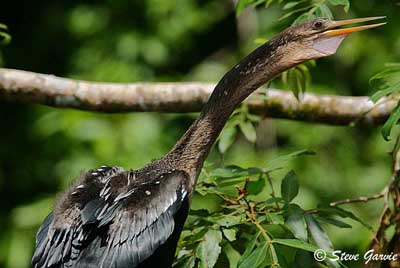
Anhinga is highly territorial, performing exaggerated displays to defend the nest site. It spreads the wings and snaps the beak, to threat an intruder, and if necessary, they may fight, pecking each other on neck and head.
Anhingas are solitary birds, but it may gather with herons, cormorants, ibises and storks. It nests in loose colonies with its species and others, but it is not found with other Anhingas out of nesting colonies.
Anhinga spends much of its time in the water to fish. But after to swim, it has to perch to dry its feathers. It has to spread out its wings to dry its plumage and get heat from the sun. It is necessary for this bird, to maintain its body temperature. Anhinga does not have oil glands to protect its feathers, like most water birds. This helps it to dive and chase fish underwater. It can fly with wet plumage, but it is not easy.
FLIGHT:
Anhingas have large and broad wings that allow them to soar very well, and flying in horizontal flight, alternating wing beats and glides. To take off, Anhinga may run on the water surface, or dive from a tree.
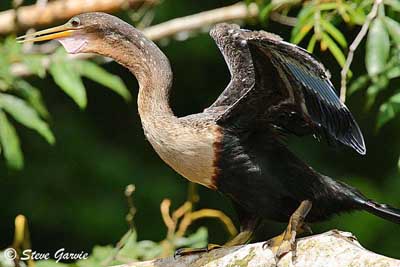
REPRODUCTION:
Anhinga’s nest is built by both adults. Male brings nesting material and female builds the platform, situated on a branch above water, or in top of tree in open land, at about 4 to 20 feet high. Female weaves sticks together, and pads them with fresh twigs and leaves.
Female lays 2 to 5 bluish-white or pale green eggs. Incubation lasts about 25 to 30 days, by both parents. Chicks hatch naked and helpless. They may have some white and dark down on the sides of their body, and they are brooded by both parents for 12 days.
First, parents feed chicks by dripping fluid and regurgitation of fish directly into their open throats. When chicks become older, they put the head into parent’s bills to get food.
They stay at nest three weeks, and then, they climb on a branch near the nest, and they fledge at about six weeks. They remain with parents for several weeks.
If young are threatened at nest, they are able, at about three weeks, to drop into water and swim to escape.
Young reach their sexual maturity at about 2 years old.
DIET:
Anhinga feeds mainly on fish, but also aquatic invertebrates, insects, reptiles and amphibians.
PROTECTION / THREATS / STATUS:
Anhingas are abundant species in the Americas, but their habitat is threatened. Pesticides poisoning is another threat for them.
All : Amerikanischer Schlangenhalsvogel
Esp : Anhinga Americana
Ital : Aninga americana
Nd : Amerikaanse Slangenhalsvogel
Russe : Змеешейка американская
Sd: Amerikansk ormhalsfågel
Photographers:
Jean Michel Fenerole
Photos d’Oiseaux du monde
Steve Garvie
RAINBIRDER Photo galleries
Text by Nicole Bouglouan
Sources :
A GUIDE TO THE BIRDS OF MEXICO AND NORTHERN CENTRAL AMERICA by Steve N. G. Howell, Sophie Webb - Oxford University Press - ISBN: 0198540124
A GUIDE TO THE BIRDS OF COLOMBIA by Steven L. Hilty and William L. Brown
Princeton University Press – ISBN 069108372X
Animal Diversity Web (University of Michigan Museum of Zoology)
Wikipedia (Wikipedia, The Free Encyclopedia)
All About Birds (Cornell Lab of Ornithology)
